THE PIONEER AMES FAMILY
by
Mona Hyer Waibel
![]()
Indians lived in this valley before the white man arrived. The Cascadia Indian overhang-cave has interesting ancient petroglyphs showing their life. Calapooia Indians fell victim to their greatest enemy, disease. As the white man settled here, they brought diseases the tribe could not combat. Epidemics of smallpox and venereal disease wiped out the tribe. There were estimated populations of Calapooians at 13,500 from 1775 to 1800. But by 1844, when our settlers began to arrive, the tribe had shrunk to 300. In 1844 many Indians still camped in our valley. They were gentle food-gathering members of the Santiam Band of the Calapooia tribe, and the Sweet Home area had much camas that was the tribe�s staple food. Some traded their furs for food supplies at the town�s store.
The Ames
families were the first white people to discover and settle in this valley. The Ames party consisted of Lowell Ames and
wife Anna Keisler Ames, whom he married in 1819, with
their six grown sons: Alonzo (Len), John, Lowell Jr., William, Andrew and
Joseph; and daughter Polly. Son Nathan and daughter Melissa stayed behind in
Missouri. This family, members of the
Church of Latter Day Saints (Mormons), left their home in Independence, Mo.,
because of religious persecution. Gov. Boggs of Missouri issued an
�extermination or drive them away order of Mormons.� The Ameses barely escaped death by signing away their
property. The group migrated westward in
search of acceptance by their neighbors and were also uneasy that they might be
attacked by hostile Indians along the trail to Oregon. Life was difficult for
Mormons! [Note:
There seems to be a degree of confusion about their 'Mormon'
affiliation, although the family clearly indicated they were not associated
with Brigham Young & the Utah Mormons/polygamy. The family were
members of the Reorganized Church of Jesus Christ of Latter Day a Saints.
It was not uncommon for members of the RLDS church to simply refer to
themselves as Latter Day Saints or by others as 'Mormons' if there were no
Utah Mormons/LDS/Latter-day Saints in the area. Typically RLDS detest
being called 'Mormon' due to the mistaken association with the beliefs of
the Utah Mormons/Brigham Young/polygamy, etc. The RLDS church building
in Sweet Home eventually closed & remaining members traveled to Albany, OR.
The Ames family held the distinction of being the first pioneer white family to file for homesteads on land that is now Sweet Home. It was September 1852 when 52-year-old Lowell Ames headed his ox teams up the Santiam Valley. Plodding eastward, the ox teams pulled the covered wagons up and over Fern Ridge and down into the beautiful Sweet Home valley. The passage up the canyon from Lebanon was not yet opened. Just at sunset, the Ames party arrived on the banks of a sparkling stream of water, crossing over to the east bank, with their tired oxen. The large family pitched their tents and with much prayer they were safely home!
Lowell Ames built the first sawmill in Sweet Home in 1856 at the mouth of the newly named Ames Creek; the creek ran through town and emptied into the Santiam River. The mill had a capacity of sawing 1,000 board feet of lumber each day. The water-powered mill could be operated by just one man. He also built a barn from his own lumber and he did the livery stable business with all the new settlers arriving. There would be obstacles for these hardy newcomers to overcome. Eventually they did find work, either farming or working somewhere to provide for their families.
The first bridge across the Santiam River was built in 1858 on long poles and spanned the river in the approximate location of today�s Pleasant Valley Bridge. Oxen were used to put the timbers in place. Lowell made this settlement one that the newcomers found appealing.
Each of these family members would establish a homestead in the valley. Lowell Ames built the first church here in 1856, near his home. The church building was quite modern for that period, with rustic siding and was actually painted and had a shingle roof. It stood on a rise of ground on the end of Oak Terrace, behind Lenora Slater�s home. The Evangelical congregation had used the Ames Church building for some time and when the Ames family gave the Evangelical members land, they eventually built their own church in 1884. New settlers of other faiths and denominations arrived. The Ames family allowed these congregations to use their church until the newcomers could build one of their own. In those early days, pioneers always helped one another.
Lowell died March 8, 1863, spending only eight years here in the paradise that allowed him to worship. He accomplished much in that short span. Anna Ames died March 11, 1868.
Sweet Home was a very active Latter Day Saints Day colony. The Ames family was not part of the Salt Lake Mormon Church; their branch never consented to polygamy.
The Morris family, who were friends and fellow Mormons of Lowell Ames, settled just west of town; and Adam Nye homesteaded in the Liberty area. It was also 1852 when Andrew Wiley arrived, settling on Whiskey Butte. Andrew Wiley led explorers across the Cascades, finding a passageway into Eastern Oregon. Other families who arrived after Wiley were the Mosses, Barrs, Pickenses, Simons, Gillilands, Rices, Robnetts, Splawns, Malones, Philpotts and the Matlocks. There was land for the pickin� in this isolated valley. Families became spread out.
In 1864, this community had its first frame house. Things were looking up and the community soon flourished. In the late 1860s and the early 1870s the first store buildings were constructed. These early frame buildings included a post office, a hotel and the general store that had many items the settlers needed. Some of the early storekeepers were Asher Hamilton, John Donaca, Frank Rumbo and Hahn. On July 3, 1893 a bad fire in the settlement leveled the post office and the general store.
In 1874, on
the William Ames donation land claim, the first school building was constructed.
The rough lumber was lovingly formed into a large box shape by many anxious
fathers who wanted education for their children. The teacher was a single woman
named Luella Colbert, who later became the bride of Frank Robinette and lived
her life in the Crawfordsville area. 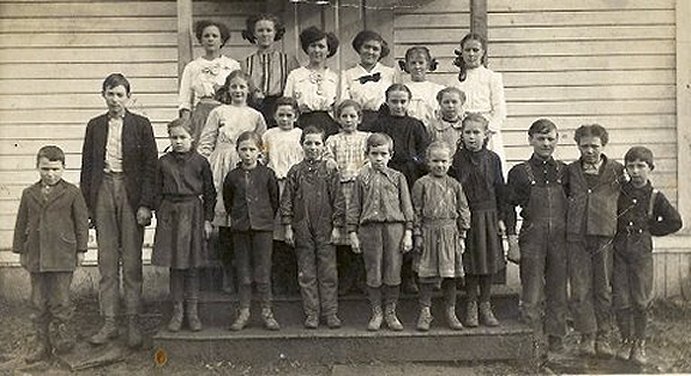
The excited students arrived, among them Enos and Oliver Russell; George, Dorothy, Hiram and Geneva Pickens; Alfred Dunning; Lilly and Etta Wiley and Retta Gilliland. No Ames children attended, although several were of school age. The school house burned in 1882, when Ann Mealey was teaching. Several other school buildings were constructed through the years. One important one was the Long Street School that was built in 1910. This building would continually serve the community many years and where my family were taught the 3 R�s.
In 1879, a furniture factory was built by Thomas Watkins and James Abbott near the Ames Creek bridge and lumber from the Ames sawmill was used. My family had several of the rawhide bottom chairs that were built there and I have two of them today. Power to operate the mill came by a ditch that ran from Ames Creek. Later the factory became a tannery and produced fine leather.
The Ames family gave land for the area�s first community cemetery, and of course this family is all buried there. The Ames cemetery is still part of the cemetery district.
Early Sweet Home had no bank for lending money. Lowell Ames Jr. took his shovel into the garden and dug up a fruit jar containing gold and would loan this at his private office. Then he would hide the jar in a new place.
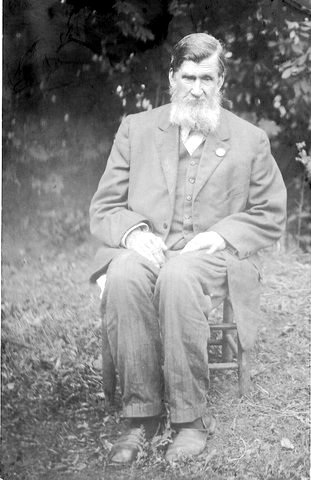 Joseph Ames,
born in 1840, was an interesting man who looked ahead at what a town should be
like. It was Joe who surveyed and
platted four city blocks in an area he felt would be the heart of Sweet Home.
These lots were put on sale for $10 each and the town knew where to start
building.
Joseph Ames,
born in 1840, was an interesting man who looked ahead at what a town should be
like. It was Joe who surveyed and
platted four city blocks in an area he felt would be the heart of Sweet Home.
These lots were put on sale for $10 each and the town knew where to start
building.
Joseph didn�t get his 159.96 acres of land because he was too young to apply. He never married. Alonzo also did not marry, but he did get his acres of land from the Oregon Donation Land Act in the northeastern section of town.
Young Andrew owned the first bicycle in town, and was the envy of all the children. Andrew neglected to file for his acreage. Son Byron was a fighter, and liked to use his fists. Jim Keeney stood guard with his six-shooter over one fight that was next to the community store. Many watched the fracas. Andrew Ames married Marietta Blake and had five children � Esther, David, Almira, John and Byron Andrew Jackson Ames. Byron Ames later married Edna Lois Turner; they had 16 children, many still living in Oregon.
Byron and sons
were in the logging/sawmill business.
Byron�s son John and wife Shirley Ames attend annual Ames reunions at
Dallas. 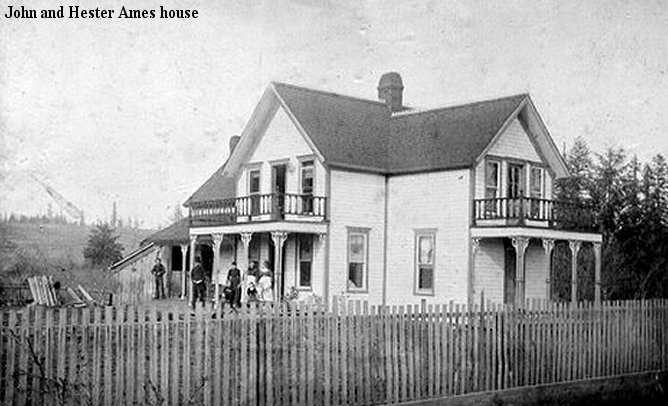
John T. Ames
staked his claim and built a home half a mile west of Sweet Home. He and wife,
Hester Ames, who was his second cousin, had two sons, Courtney and Lossie, and one daughter, Mabel.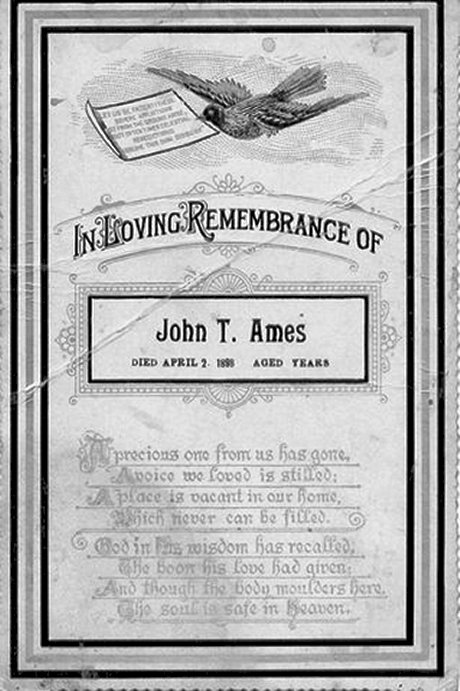
John died in 1898; in 1902 Hester married his brother Andrew, who was by then a widower. Andrew Ames died shortly after remarrying. Hester bore the Ames name her entire life and moved to Lents with her children to southeast Portland in 1909. She had only one grandchild, Mabel�s daughter Wilma, who died in 2003. Hester�s younger sister Birdie was the great-grandmother of Judie Bunch and Joyce Gray, of whom I will talk later. Birdie lived several years in Sweet Home with Hester, and finished her life in Lents, also with Hester. Hester died in 1932, and Birdie in 1939.
William Ames
filed entry on 160 acres inside the city limits. A married man could own up to
320 acres and a single 160. Those living here before 1850 could get double
acres. He and Isabelle had sons Zenos and Eden, and three daughters: Zillah Ames Keeney,
born May 26, 1878; Ada Ames Rozelle; and Eldora Ames Boggs. 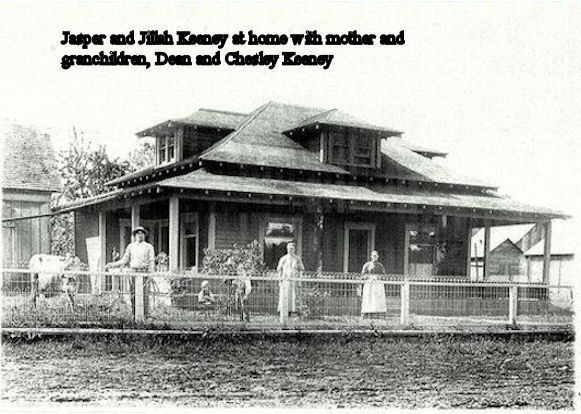
Zillah and Jaspar�s (Jack) children were: Leathea; Chesley James, born in 1908; and William Dean Keeney, born in 1910. Now these names are familiar! There will be a story on the Keeney family in the future.
The 1870 census gave Sweet Home a population of 199, with the Ames family now included. The Post Office was established in 1874, with John B. Hughes as postmaster, (some old records show 1873 as the year the Post Office was established and John Young as postmaster � you decide) and the town incorporated in 1893.
We were becoming a community. Soon there would be a flour mill, a blacksmith shop, a feed and livery barn, a wagon shop, a steam sawmill, the Latter Day Saints of Jesus Christ Church meeting place, a community store and a school.
Supplies for the store were brought into town on a wagon by a team of oxen. It would be a long trip winding around the trail into town. Mail came once a week by horseback.
It was an isolated area for those early pioneers, who made close friends of the other settlers� family. No one was excluded by their religion.
Eventually, this Mormon group of several families disbanded, although many new Mormons do live locally today. The oldest continuing church body in Sweet Home is the Evangelical church. The original church building constructed in 1884 was used by many other congregations.
The Evangelical�s charter membership included names such as the Thompsons (my family), Nothiger, Riggs, Spring, Trachsel, Morris, Rumbaugh, Hirschi, Galbraith, Brooks, Jackson and Moran. The land and the lumber for the lone church came as a gift from Ames� descendents. Most of the city�s early land was owned by the Ames family.
In the center of town, the settlers had cow pastures and unfenced livestock roamed the dusty streets. Trails ran through the town and around the businesses that were open long hours for the settlers in horse drawn wagons who came for supplies. On the edge of town the heavy underbrush and timberlands protected the area from winds and the mountains that towered above gave a gentle climate to the Sweet Home populace.
The Ames family today
As you would imagine, many descendents live in Sweet Home and surrounding area. Lenora Ames Slater and Wayne did live on Oak Terrace; our neighbors. Wayne has now passed on. Lenora is the daughter of Loren Ames aka Rabbit, and mother of daughters Ileta and Terry. Lenora has one grandson. Her sister Phyllis Ames, born Sept. 10, 1941, lives on Ames Creek nearby. She left school after the eighth grade. Phyllis, who lost a son in an accident, has a daughter, Tina Lester, born Nov. 18, 1966, and two grandsons, Neil Van Epps born Nov. 15, 1988 and Tanner Lester, born August 1990.
Lloyd Zenas Ames, 1902 -1973, was the son of Zenas Ames. He fathered Fay, Doris, Dorothy (my classmate), Deloris, Cleo, Eldon, Eldred, Edwin (aka Buckshot), and Diana, the youngest.
Cleo Ames Little, born June 2, 1935, died recently. Her property was part of the old Ames homestead, near the Elks lodge. She left one son, Danny Little, and five grandchildren. Cleo lived most of her childhood in the Quartzville area.
The Ames family held family reunions at Cascadia Park. Each year Cleo�s uncles Rabbit, Virgil, Kenneth and aunts Eva and Neva � the twins � and Zenona came with a picnic lunch but the children quit attending. One year in July they celebrated Lloyd and Nora�s 50th anniversary; by a mistake they celebrated a year early and Lloyd died Jan. 6 of that year.
Cleo�s brother Edwin lives in Cascadia, a retired welder who worked in logging as most area residents did.
Virgil Ames married Marie Hogan; they had three boys. Duane lives in Milwaukie, Donnie and Norman are deceased. As the generations grew to picnics of 100 or more, the family reunions came less often. Ames Cemetery became the family�s final resting place. Lloyd�s headstone also listed the name �Rabbit.�
Eldred and Jeanie Ames, local residents, have been researching Ames family records. Eldred is also Cleo and Edwin (Buckshot�s) brother and the son of Lloyd. The number of descendents living locally is quite enormous.
The Ames cemetery was originally used for immediate family members. But over time as the family members married and the family had other names besides Ames, the cemetery did welcome these persons to use this as their final resting place. The cemetery is located on the edge of town on Highway 228, overlooking some of the newer homes.
Judie Quinlin Bunch of Talent also is an Ames family cousin, as well as her sister Joyce Quinlin Gray, who resides in Portland. Judie has three living children and one grandson. Joyce has two children and two grandsons.
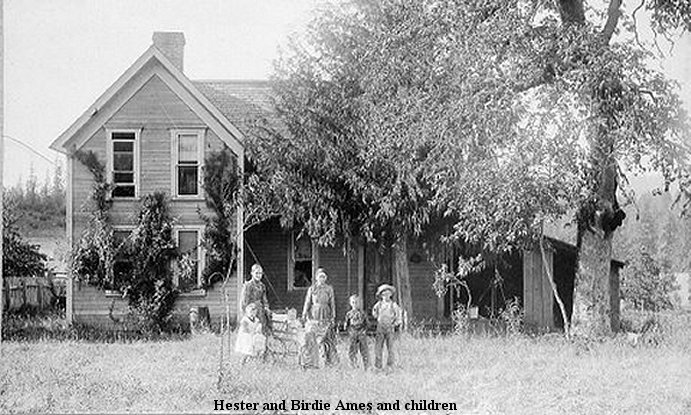 Doris was the only granddaughter of Margaret
�Birdie� Ames. Birdie was a sister of Hester who married John T. Ames. Judie and
Joyce�s mother was the granddaughter of Birdie.
Their mother Doris Eastman Quinlin died in 1998.
Doris was the only granddaughter of Margaret
�Birdie� Ames. Birdie was a sister of Hester who married John T. Ames. Judie and
Joyce�s mother was the granddaughter of Birdie.
Their mother Doris Eastman Quinlin died in 1998.
Judie has written much about this famous family in a research book available at East Linn Museum, Sweet Home city library and Genealogy Library. The Quinlin sisters say, �We grew up hearing stories about the Ames family and Sweet Home.� And now you do too.
Thank you to Lenora, Cleo, Phyllis, Jeanie, Joyce and Judie for help with this story. And thank you, Ames family, for giving Sweet Home an early start in the good old days.
![]()
My name is Stephenie Flora. Thanks for stopping by. Return to [ Home Page ] All [ Comments and Inquiries ] are welcome.